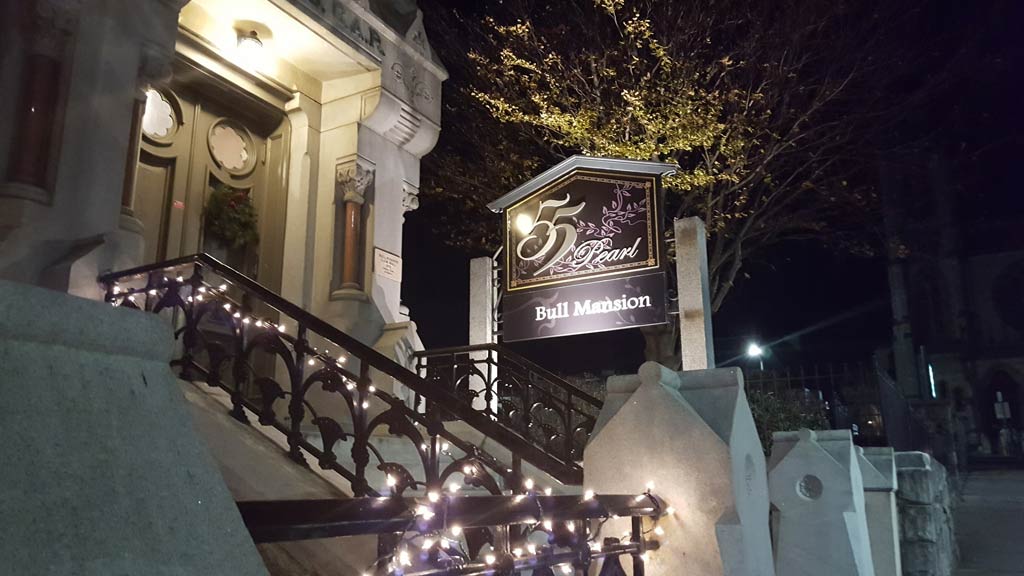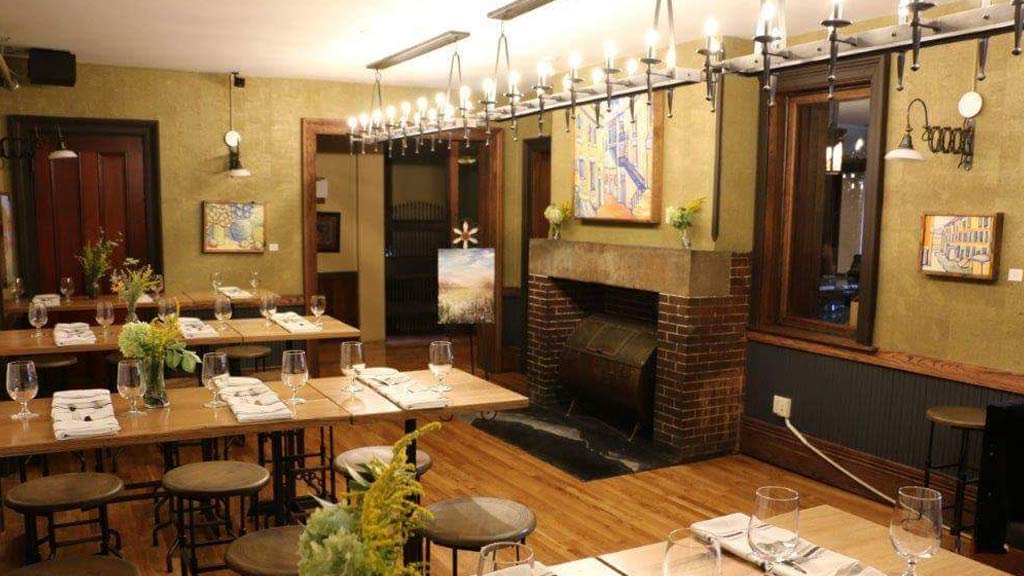Located in Worcester, Bull Mansion stands as a symbol of historical significance and architectural charm. Originally built in 1876 by Alexander Bullock, the former Massachusetts Governor, this majestic mansion has witnessed a myriad of transformations over the decades.
Initially serving as a residence for the Bullock family, it later evolved into a prominent social hub, hosting distinguished guests and lavish gatherings.
Throughout its rich history, Bull Mansion has weathered various chapters, from being a speakeasy during Prohibition to a contemporary venue for cultural events and fine dining. Its elegant Victorian-era design, coupled with its storied past, continues to allure visitors, offering a glimpse into Worcester’s captivating heritage.
Bull Mansion Worcester History
The Bull Mansion in Worcester, Massachusetts, holds a rich history that spans several centuries.
Here’s a history timeline highlighting the key events Bull Mansion Worcester:
The Construction of Burbank Mansion (1740s)
Colonel Elijah Burbank, a respected figure in Worcester’s early colonial history, oversees the construction of the original Burbank Mansion.
Located strategically in downtown Worcester, the mansion becomes a symbol of Burbank’s status and influence in the community.
Crafted in the colonial architectural style of the time, the mansion boasts sturdy timber frames, a steeply pitched roof, and simple yet elegant detailing that reflects the tastes of the era.
Burbank, along with his family, settles into the mansion, using it not only as a residence but also as a center for social gatherings and business dealings, further solidifying its importance in Worcester’s nascent society.
The Evolution of Burbank Mansion (Late 1700s)

Worcester undergoes a period of rapid growth and development, fueled by its strategic location as a hub for trade and commerce.
Sensing the opportunity, the Burbank Mansion expands and undergoes renovations to accommodate the burgeoning needs of its inhabitants.
Additional wings are added, and interior spaces are remodeled to reflect the changing architectural trends of the late 18th century.
The mansion becomes a focal point of Worcester’s social life, hosting gatherings that bring together the town’s leading citizens, merchants, and political figures.
Transformations Under Jonathan Grout (Early 1800s)
With the turn of the century, ownership of the mansion changes hands, marking a new chapter in its history.
Jonathan Grout, a prominent businessman and politician, acquires the property, infusing it with his own vision and aspirations.
Grout’s tenure in the mansion coincides with a period of industrialization and economic prosperity in Worcester, as the town becomes increasingly interconnected with regional and national markets.
The mansion serves not only as a private residence for the Grout family but also as a symbol of their success and prominence in Worcester’s growing commercial landscape.
Mid to Late 1800s: Victorian Splendor
As Worcester continues to thrive, the mansion experiences further transformations under new owners who seek to modernize and expand the property.
Architectural styles evolve, reflecting the changing tastes and preferences of the Victorian era.
Elaborate ornamentation, intricate woodwork, and decorative flourishes adorn the mansion’s façade and interior spaces, signaling the wealth and social status of its occupants.
The mansion becomes a showcase of Victorian opulence, attracting admiration and envy from all who behold its grandeur.
Late 1800s to Early 1900s

The Bull family acquires the mansion, leaving an indelible mark on its history and identity. Renamed Bull Mansion in honor of its new owners, the property undergoes extensive renovations and enhancements, transforming it into a true masterpiece of Gilded Age architecture.
The Bull family spares no expense in embellishing the mansion with luxurious amenities, including ornate chandeliers, marble fireplaces, and stained glass windows, creating an atmosphere of unparalleled elegance and sophistication.
Bull Mansion becomes the crown jewel of Worcester’s social scene, playing host to extravagant balls, soirées, and galas attended by the city’s elite.
20th Century: Continued Grandeur
Bull Mansion maintains its status as a premier destination for high society gatherings throughout the early decades of the 20th century.
However, as societal norms shift and economic pressures mount, the mansion faces challenges in adapting to the changing times.
Maintenance costs escalate, and upkeep becomes increasingly burdensome for the owners. Despite efforts to preserve its legacy, Bull Mansion begins to show signs of neglect and decline, as its once-gleaming façade fades into obscurity.
Mid to Late 20th Century: Challenges and Decline
The latter half of the 20th century sees Bull Mansion fall into disrepair, as changing social dynamics and urban development trends take their toll on the historic property.
Neglect and vandalism threaten the mansion’s structural integrity, casting doubt on its future viability.
Concerned citizens and preservationists rally to save Bull Mansion from further deterioration, advocating for its restoration and rehabilitation as a vital piece of Worcester’s architectural heritage.
21st Century: A Beacon of Hope
A renewed sense of purpose emerges as efforts to rescue Bull Mansion gain momentum in the early 21st century.
A coalition of stakeholders, including preservation organizations, local businesses, and government entities, collaborate to fund and oversee extensive restoration work aimed at returning the mansion to its former glory.
Historic features are painstakingly preserved, while modern amenities are discreetly integrated to ensure the mansion’s relevance in the contemporary era.
In 2015, Bull Mansion proudly reopens its doors to the public, signaling a triumphant revival of Worcester’s architectural gem.
Today, Bull Mansion stands as a testament to the power of preservation and community engagement, offering visitors a glimpse into Worcester’s storied past while embracing its role as a vivid cultural hub for generations to come.
FAQs
What is the significance of Bull Mansion in Worcester’s history?
Bull Mansion holds significant historical importance as a prominent architectural landmark in Worcester, Massachusetts.
Originally built in the 19th century, it has witnessed various transformations and played a vital role in the city’s social, cultural, and economic development over the years.
Who were some notable figures associated with Bull Mansion?
Bull Mansion has been associated with several notable figures throughout its history, including Alexander Bullock, a former Massachusetts Governor, and Jonathan Grout, a prominent businessman and politician.
These individuals contributed to shaping the mansion’s identity and its impact on Worcester’s community.
What architectural styles characterize Bull Mansion?
Bull Mansion features a blend of architectural styles, reflecting its evolution over time.
From its colonial origins with simple yet elegant detailing to its transformation into a showcase of Victorian opulence, the mansion boasts a rich architectural heritage that appeals to enthusiasts and historians alike.
How did Bull Mansion adapt to changing societal norms and economic pressures?
Like many historical properties, Bull Mansion faced challenges in adapting to changing societal norms and economic pressures, particularly during the 20th century.
Despite periods of decline and neglect, efforts from preservationists and community stakeholders have led to its restoration and revival, ensuring its continued relevance and significance in the modern era.
What role does Bull Mansion play in Worcester today?
Today, Bull Mansion serves as more than just a historical landmark; it is a vivid cultural hub that hosts a variety of events, including cultural gatherings, fine dining experiences, and community celebrations.
Its restored grandeur and rich heritage continue to captivate visitors, offering a glimpse into Worcester’s captivating past while embracing its role as a dynamic part of the city’s present and future.
Conclusion
In conclusion, the history of Bull Mansion in Worcester, Massachusetts, stands as a testament to resilience, preservation, and community spirit.
From its origins as the Burbank Mansion in the colonial era to its transformation into a beacon of Victorian splendor as Bull Mansion, this architectural gem has weathered centuries of change.
Despite facing challenges and periods of decline, Bull Mansion’s story is one of revival and renewal, thanks to the dedicated efforts of preservationists and community stakeholders.
Today, Bull Mansion proudly stands as a symbol of Worcester’s rich heritage, inviting visitors to step back in time while embracing its role as a vivid cultural hub for the future.
Jaclyn Lowe